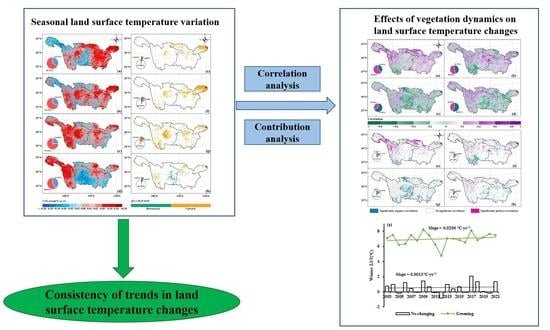The Response of Land Surface Temperature Changes to the Vegetation Dynamics in the Yangtze River Basin
Abstract
1. Introduction
2. Materials and Methods
2.1. Study Area
2.2. Data Sources
2.3. Methods
2.3.1. Trend Analysis
- (1)
- Theil–Sen estimator
- (2)
- Mann–Kendall (MK) test
- (1)
- Define the term “”
- (2)
- Calculate the MK test statistic S
- (3)
- Compute the variance
- (4)
- The standard normal test statistic is expressed as
2.3.2. Correlation Analysis
2.3.3. Hurst Exponent
- (1)
- Divide the long time series {} () into subseries , and for each series,
- (2)
- Define the long-term memory of the time series of the mean LST
- (3)
- Calculate the accumulated deviation from each mean LST
- (4)
- Define the range sequence of
- (5)
- Define the standard deviation sequence of
- (6)
- Calculate the Hurst exponent
- (7)
- The value is acquired by fitting the following formula
2.3.4. Contribution Analysis
3. Results
3.1. Trend Characteristics of Interannual LST
3.2. Seasonal LST Variation
3.3. Consistency of Trends in LST Changes
3.4. The Characteristics of the Vegetation Dynamics
3.5. Contribution of Vegetation Changes to LST
4. Discussion
4.1. The Spatial and Temporal Change of LST
4.2. Clarification of Biophysical Mechanisms of Interaction between LST and Vegetation
5. Conclusions
Author Contributions
Funding
Data Availability Statement
Acknowledgments
Conflicts of Interest
References
- Yan, Y.; Mao, K.; Shi, J.; Piao, S.; Shen, X.; Dozier, J.; Liu, Y.; Ren, H.-L.; Bao, Q. Driving forces of land surface temperature anomalous changes in North America in 2002–2018. Sci. Rep. 2020, 10, 1–13. [Google Scholar] [CrossRef]
- Zhao, B.; Mao, K.B.; Cai, Y.L.; Meng, J.X. Study of the temporal and spatial evolution law of land surface temperature in China. Remote Sens. Land Resour. 2020, 32, 233–240. [Google Scholar]
- Du, Q.; Zhang, M.; Wang, S.; Che, C.; Ma, R.; Ma, Z. Changes in air temperature over China in response to the recent global warming hiatus. J. Geogr. Sci. 2019, 29, 496–516. [Google Scholar] [CrossRef]
- Yu, Y.; Duan, S.-B.; Li, Z.-L.; Chang, S.; Xing, Z.; Leng, P.; Gao, M. Interannual Spatiotemporal Variations of Land Surface Temperature in China From 2003 to 2018. IEEE J. Sel. Top. Appl. Earth Obs. Remote Sens. 2021, 14, 1783–1795. [Google Scholar] [CrossRef]
- Moradi, M.; Darand, M. Trend analysis of land surface temperature over Iran based on land cover and topography. Int. J. Environ. Sci. Technol. 2022, 19, 1–14. [Google Scholar] [CrossRef]
- Easterling, D.R.; Wehner, M.F. Is the climate warming or cooling? Geophys. Res. Lett. 2009, 36, L08706. [Google Scholar] [CrossRef]
- European Environmental Agency. The European Environment State and Outlook 2010-Assessment of Global Megatrends; European Environmental Agency: Copenhagen, Denmark, 2010. [Google Scholar]
- Feng, J.M.; Liu, Y.H.; Yan, Z.W. Analysis of surface air temperature warming rate of China in the last 50 years (1962–2011) using k-means clustering. Theor. Appl. Climatol. 2015, 120, 785–796. [Google Scholar]
- Cao, L.; Zhu, Y.; Tang, G.; Yuan, F.; Yan, Z. Climatic warming in China according to a homogenized data set from 2419 stations. Int. J. Climatol. 2016, 36, 4384–4392. [Google Scholar] [CrossRef]
- Wei, B.; Bao, Y.; Yu, S.; Yin, S.; Zhang, Y. Analysis of land surface temperature variation based on MODIS data a case study of the agricultural pastural ecotone of northern China. Int. J. Appl. Earth Obs. Geoinf. ITC J. 2021, 100, 102342. [Google Scholar] [CrossRef]
- Yang, M.; Zhao, W.; Zhan, Q.; Xiong, D. Spatiotemporal Patterns of Land Surface Temperature Change in the Tibetan Plateau Based on MODIS/Terra Daily Product From 2000 to 2018. IEEE J. Sel. Top. Appl. Earth Obs. Remote Sens. 2021, 14, 6501–6514. [Google Scholar] [CrossRef]
- Yu, Z. Changes of Ground Temperature in Sichuan and Evaluation Model; Cheng University of Technology: Chengdu, China, 2017. [Google Scholar]
- Mazhar, U.; Jin, S.; Duan, W.; Bilal, M.; Ali, A.; Farooq, H. Spatio-Temporal Trends of Surface Energy Budget in Tibet from Satellite Remote Sensing Observations and Reanalysis Data. Remote Sens. 2021, 13, 256. [Google Scholar] [CrossRef]
- He, Y.F.; Chen, C.; Li, B.; Zhang, Z.L. Prediction of near-surface air temperature in glacier regions using ERA5 data and the random forest regression method. Remote Sens. Appl. Soc. Environ. 2022, 28, 2352–9385. [Google Scholar]
- Duan, S.-B.; Li, Z.-L.; Li, H.; Göttsche, F.-M.; Wu, H.; Zhao, W.; Leng, P.; Zhang, X.; Coll, C. Validation of Collection 6 MODIS land surface temperature product using in situ measurements. Remote Sens. Environ. 2019, 225, 16–29. [Google Scholar] [CrossRef]
- Zhang, Z.; Lin, A.; Zhao, L.; Zhao, B. Attribution of local land surface temperature variations response to irrigation over the North China Plain. Sci. Total Environ. 2022, 826, 154104. [Google Scholar] [CrossRef] [PubMed]
- Mao, K.; Ma, Y.; Tan, X.; Shen, X.; Liu, G.; Li, Z.; Chen, J.; Xia, L. Global surface temperature change analysis based on MODIS data in recent twelve years. Adv. Space Res. 2016, 59, 503–512. [Google Scholar] [CrossRef]
- Liu, Y.X.; Yang, Y.B.; Hu, J.; Meng, X.J.; Kuang, K.X.; Hu, X.J.D.; Bao, Y. Temporal and spatial characteristics of diurnal surface urban heat island intensity in China based on long time series MODIS data. Int. J. Geogr. Inf. Sci. 2022, 24, 981–995. [Google Scholar]
- Aguilar-Lome, J.; Espinoza-Villar, R.; Espinoza, J.-C.; Rojas-Acuña, J.; Willems, B.L.; Leyva-Molina, W.-M. Elevation-dependent warming of land surface temperatures in the Andes assessed using MODIS LST time series (2000–2017). Int. J. Appl. Earth Obs. Geoinf. ITC J. 2019, 77, 119–128. [Google Scholar] [CrossRef]
- Vargas Zeppetello, L.R.; Donohoe, A.; Battisti, D.S. Does surface temperature respond to or determine downwelling longwave radiation? Geophys. Res. Lett. 2019, 46, 2781–2789. [Google Scholar] [CrossRef]
- Kim, H.-M.; Kim, B.-M. Relative Contributions of Atmospheric Energy Transport and Sea Ice Loss to the Recent Warm Arctic Winter. J. Clim. 2017, 30, 7441–7450. [Google Scholar] [CrossRef]
- Boucher, O.; Randall, D.; Artaxo, P.; Bretherton, C.; Feingold, G.; Forster, P.; Kerminen, V.M.; Kondo, Y.; Liao, H.; Lohmann, U.; et al. Clouds and Aerosols. In Climate Change 2013: The Physical Science Basis; Cambridge University Press: Cambridge, UK, 2014; pp. 571–657. [Google Scholar]
- Chen, W.; Bai, S.; Zhao, H.; Han, X.; Li, L. Spatiotemporal analysis and potential impact factors of vegetation variation in the karst region of Southwest China. Environ. Sci. Pollut. Res. 2021, 28, 61258–61273. [Google Scholar] [CrossRef]
- Duan, J.; Li, L.; Fang, Y. Seasonal spatial heterogeneity of warming rates on the Tibetan Plateau over the past 30 years. Sci. Rep. 2015, 5, srep11725. [Google Scholar] [CrossRef] [PubMed]
- Yang, Q.; Huang, X.; Tang, Q. Global assessment of the impact of irrigation on land surface temperature. Sci. Bull. 2020, 65, 1440–1443. [Google Scholar] [CrossRef]
- Zhang, H.; Wang, F.; Wang, F.; Li, J.D.; Chen, X.L.; Wang, Z.Z.; Li, J.; Zhou, X.X.; Wang, Q.Y.; Wang, H.B.; et al. Research progress of cloud radiation feedback in global climate change. Sci. China Earth Sci. 2022, 52, 400–417. [Google Scholar]
- Yu, P.; Li, Y.; Liu, S.; Liu, J.; Ding, Z.; Ma, M.; Tang, X. Afforestation influences soil organic carbon and its fractions associated with aggregates in a karst region of Southwest China. Sci. Total Environ. 2022, 814, 152710. [Google Scholar] [CrossRef]
- Zhang, Y.-X.; Wang, Y.-K.; Fu, B.; Dixit, A.M.; Chaudhary, S.; Wang, S. Impact of climatic factors on vegetation dynamics in the upper Yangtze River basin in China. J. Mt. Sci. 2020, 17, 1235–1250. [Google Scholar] [CrossRef]
- Li, Y.; Zhao, M.; Mildrexler, D.J.; Motesharrei, S.; Mu, Q.; Kalnay, E.; Zhao, F.; Li, S.; Wang, K. Potential and Actual impacts of deforestation and afforestation on land surface temperature. J. Geophys. Res. Atmos. 2016, 121, 14372–14386. [Google Scholar] [CrossRef]
- Jiang, L.L.; Guli, J.; Bao, A.M.; Guo, H.; Ndayisaba, F. Vegetation dynamics and responses to climate change and human activities in Central Asia. Sci. Total Environ. 2017, 599–600, 967–980. [Google Scholar] [CrossRef] [PubMed]
- Chu, H.; Venevsky, S.; Wu, C.; Wang, M. NDVI-based vegetation dynamics and its response to climate changes at Amur-Heilongjiang River Basin from 1982 to 2015. Sci. Total Environ. 2018, 650, 2051–2062. [Google Scholar] [CrossRef]
- Yuan, G.; Tang, W.; Zuo, T.; Li, E.; Zhang, L.; Liu, Y. Impacts of afforestation on land surface temperature in different regions of China. Agric. For. Meteorol. 2022, 318. [Google Scholar] [CrossRef]
- Xue, Y.; Lu, H.; Guan, Y.; Tian, P.; Yao, T. Impact of thermal condition on vegetation feedback under greening trend of China. Sci. Total Environ. 2021, 785, 147380. [Google Scholar] [CrossRef]
- Peng, S.-S.; Piao, S.; Zeng, Z.; Ciais, P.; Zhou, L.; Li, L.Z.X.; Myneni, R.B.; Yin, Y.; Zeng, H. Afforestation in China cools local land surface temperature. Proc. Natl. Acad. Sci. USA 2014, 111, 2915–2919. [Google Scholar] [CrossRef] [PubMed]
- Peng, J.; Ma, J.; Liu, Q.; Liu, Y.; Hu, Y.; Li, Y.; Yue, Y. Spatial-temporal change of land surface temperature across 285 cities in China: An urban-rural contrast perspective. Sci. Total Environ. 2018, 635, 487–497. [Google Scholar] [CrossRef] [PubMed]
- Xiao, R.; Cao, W.; Liu, Y.; Lu, B. The impacts of landscape patterns spatio-temporal changes on land surface temperature from a multi-scale perspective: A case study of the Yangtze River Delta. Sci. Total Environ. 2022, 821, 153381. [Google Scholar] [CrossRef] [PubMed]
- Srivastava, A.; Rodriguez, J.; Saco, P.; Kumari, N.; Yetemen, O. Global Analysis of Atmospheric Transmissivity Using Cloud Cover, Aridity and Flux Network Datasets. Remote Sens. 2021, 13, 1716. [Google Scholar] [CrossRef]
- Zhou, D.; Xiao, J.; Frolking, S.; Liu, S.; Zhang, L.; Cui, Y.; Zhou, G. Croplands intensify regional and global warming according to satellite observations. Remote Sens. Environ. 2021, 264, 112585. [Google Scholar] [CrossRef]
- Huang, Y.; Jiang, N.; Shen, M.; Guo, L. Effect of preseason diurnal temperature range on the start of vegetation growing season in the Northern Hemisphere. Ecol. Indic. 2020, 112, 106161. [Google Scholar] [CrossRef]
- Zhan, M.Y.; Wang, G.J.; Lu, J.; Chen, L.Q.; Zhu, C.X.; Jiang, T.; Wand, Y.J. Projected evapotranspiration and the influencing factors in the Yangtze River Basin based on CMIP6 models. Trans. Atmos. Sci. 2020, 43, 1115–1126. [Google Scholar]
- Wang, L.; Qiu, X.; Wang, P.; Wang, X.; Liu, A. Influence of complex topography on global solar radiation in the Yangtze River Basin. J. Geogr. Sci. 2014, 24, 980–992. [Google Scholar] [CrossRef][Green Version]
- Deng, Y.; Jiang, W.; Tang, Z.; Ling, Z.; Wu, Z. Long-Term Changes of Open-Surface Water Bodies in the Yangtze River Basin Based on the Google Earth Engine Cloud Platform. Remote Sens. 2019, 11, 2213. [Google Scholar] [CrossRef]
- Feng, H.; Zou, B. A greening world enhances the surface-air temperature difference. Sci. Total Environ. 2018, 658, 385–394. [Google Scholar] [CrossRef]
- Song, Z.; Yang, H.; Huang, X.; Yu, W.; Huang, J.; Ma, M. The spatiotemporal pattern and influencing factors of land surface temperature change in China from 2003 to 2019. Int. J. Appl. Earth Obs. Geoinf. ITC J. 2021, 104, 102537. [Google Scholar] [CrossRef]
- Jiapaer, G.; Liang, S.L.; Yi, Q.X.; Liu, J.P. Vegetation dynamics and responses to recent climate change in Xinjiang using leaf area index as an indicator. Ecol. Indic. 2015, 58, 64–76. [Google Scholar]
- Wang, X.; Xiao, J.; Li, X.; Cheng, G.; Ma, M.; Zhu, G.; Arain, M.A.; Black, T.A.; Jassal, R.S. No trends in spring and autumn phenology during the global warming hiatus. Nat. Commun. 2019, 10, 1–10. [Google Scholar] [CrossRef] [PubMed]
- Zhao, J.; Zhang, S.; Yang, K.; Zhu, Y.; Ma, Y. Spatio-Temporal Variations of CO2 Emission from Energy Consumption in the Yangtze River Delta Region of China and Its Relationship with Nighttime Land Surface Temperature. Sustainability 2020, 12, 8388. [Google Scholar] [CrossRef]
- Huang, X.; Yang, S.; Haywood, A.; Jiang, D.; Wang, Y.; Sun, M.; Tang, Z.; Ding, Z. Warming-Induced Northwestward Migration of the Asian Summer Monsoon in the Geological Past: Evidence From Climate Simulations and Geological Reconstructions. J. Geophys. Res. Atmos. 2021, 126, e2021JD03590. [Google Scholar] [CrossRef]
- Cox, D.; MacLean, I.M.D.; Gardner, A.S.; Gaston, K.J. Global variation in diurnal asymmetry in temperature, cloud cover, specific humidity and precipitation and its association with leaf area index. Glob. Chang. Biol. 2020, 26, 7099–7111. [Google Scholar] [CrossRef]
- Zhou, X.X.; Zhang, H.; Jing, X.W. Distribution and Variation Trends of Cloud Amount and Optical Thickness over China. J. Atmos. Sci. 2016, 11, 1–13. [Google Scholar]
- Wang, Q.; Zhang, M.; Wang, S.; Ma, Q.; Sun, M. Changes in temperature extremes in the Yangtze River Basin, 1962–2011. J. Geogr. Sci. 2013, 24, 59–75. [Google Scholar] [CrossRef]
- Niu, Z.; Wang, L.; Fang, L.; Li, J.; Yao, R. Analysis of spatiotemporal variability in temperature extremes in the Yellow and Yangtze River basins during 1961–2014 based on high-density gauge observations. Int. J. Clim. 2019, 40, 1–21. [Google Scholar] [CrossRef]
- Ding, Y.H. National assessment report of climate change (i): Climate change in China and its future trend. Adv. Clim. Chang. Res. 2006, 2, 3–8. [Google Scholar]
- Zhang, Y.Y.; Xu, H.M.; Shi, N. Influence of spring Arctic Oscillation on surface air Temperature over Yangtze River Basin in mid-summer. Chin. J. Atmos. Sci. 2015, 39, 1049–1058. [Google Scholar]
- Knight, J.; Kennedy, J.J.; Folland, C.; Harris, G.; Jones, G.S.; Palmer, M. Do global temperature trends over the last decade falsify climate predictions? Bull. Am. Meteorol. Soc. 2009, 90, S20–S21. [Google Scholar]
- Medhaug, I.; Stolpe, M.B.; Fischer, E.M.; Knutti, R. Reconciling controversies about the ‘global warming hiatus’. Nature 2017, 545, 41–47. [Google Scholar] [CrossRef] [PubMed]
- Sun, X.; Ren, G.; Ren, Y.; Fang, Y.; Liu, Y.; Xue, X.; Zhang, P. A remarkable climate warming hiatus over Northeast China since 1998. Arch. Meteorol. Geophys. Bioclimatol. Ser. B 2017, 133, 579–594. [Google Scholar] [CrossRef]
- Chen, C.; Park, T.; Wang, X.; Piao, S.; Xu, B.; Chaturvedi, R.K.; Fuchs, R.; Brovkin, V.; Ciais, P.; Fensholt, R.; et al. China and India lead in greening of the world through land-use management. Nat. Sustain. 2019, 2, 122–129. [Google Scholar] [CrossRef]
- Zheng, L.; Qi, Y.; Qin, Z.; Xu, X.; Dong, J. Assessing albedo dynamics and its environmental controls of grasslands over the Tibetan Plateau. Agric. For. Meteorol. 2021, 307, 108479. [Google Scholar] [CrossRef]
- He, G.; Zhao, Y.; Wang, J.; Wang, Q.; Zhu, Y. Impact of large-scale vegetation restoration project on summer land surface temperature on the Loess Plateau, China. J. Arid Land 2018, 10, 892–904. [Google Scholar] [CrossRef]
- Shen, X.; Liu, Y.; Liu, B.; Zhang, J.; Wang, L.; Lu, X.; Jiang, M. Effect of shrub encroachment on land surface temperature in semi-arid areas of temperate regions of the Northern Hemisphere. Agric. For. Meteorol. 2022, 320, 108943. [Google Scholar] [CrossRef]
- Zhan, Y.J.; Zhang, W.; Yan, Y.; Wang, C.X.; Rong, Y.J.; Zhu, J.Y.; Lu, H.T.; Zheng, T.C. Evolution trend and influencing factors of actual evapotranspiration in the Yangtze River Basin. Acta Geol. Sin. 2021, 41, 6924–6935. [Google Scholar]
- Clinton, N.; Gong, P. MODIS detected surface urban heat islands and sinks: Global locations and controls. Remote Sens. Environ. 2013, 134, 294–304. [Google Scholar] [CrossRef]
- Jiang, W.; Niu, Z.; Wang, L.; Yao, R.; Gui, X.; Xiang, F.; Ji, Y. Impacts of Drought and Climatic Factors on Vegetation Dynamics in the Yellow River Basin and Yangtze River Basin, China. Remote Sens. 2022, 14, 930. [Google Scholar] [CrossRef]
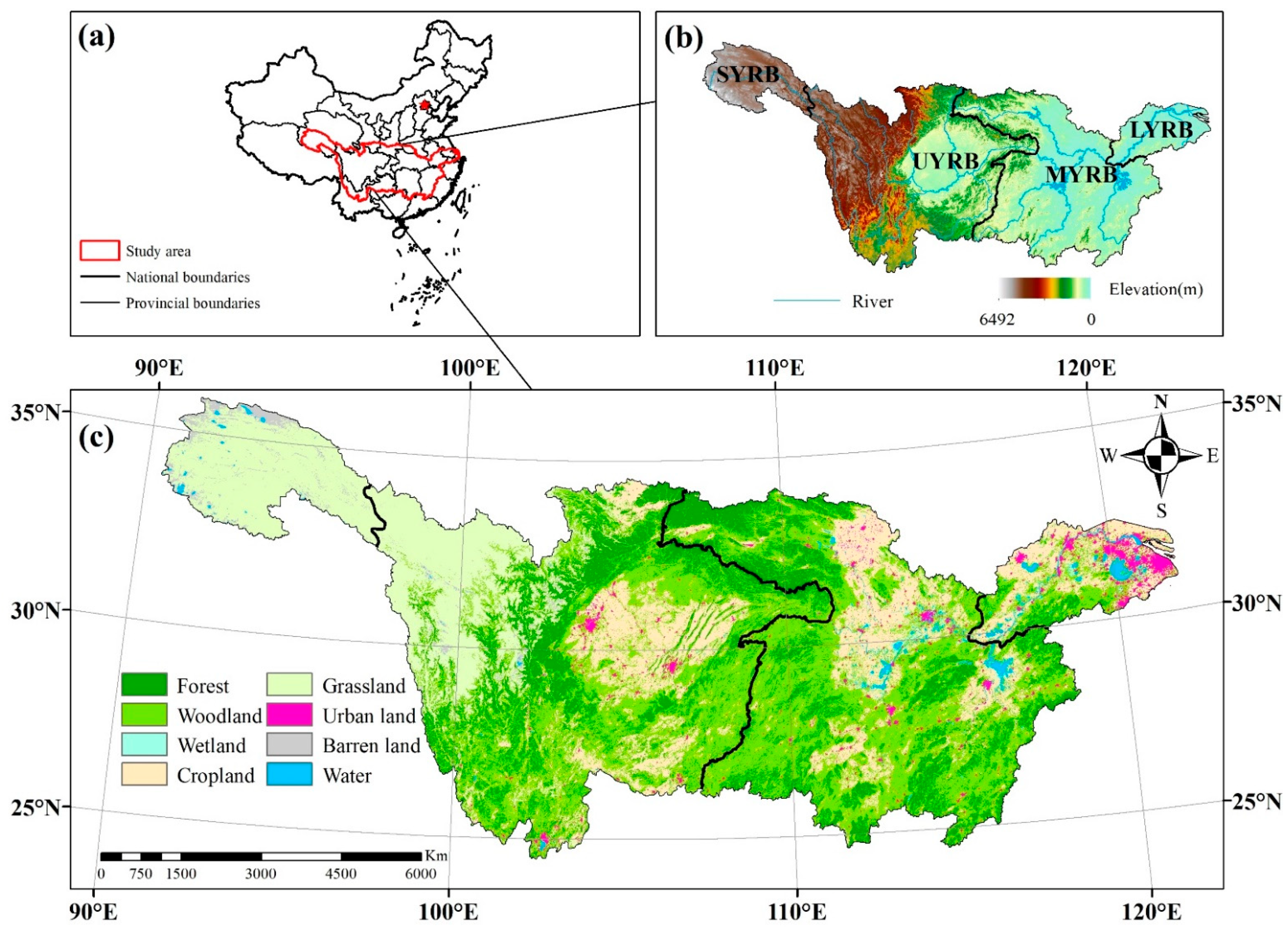
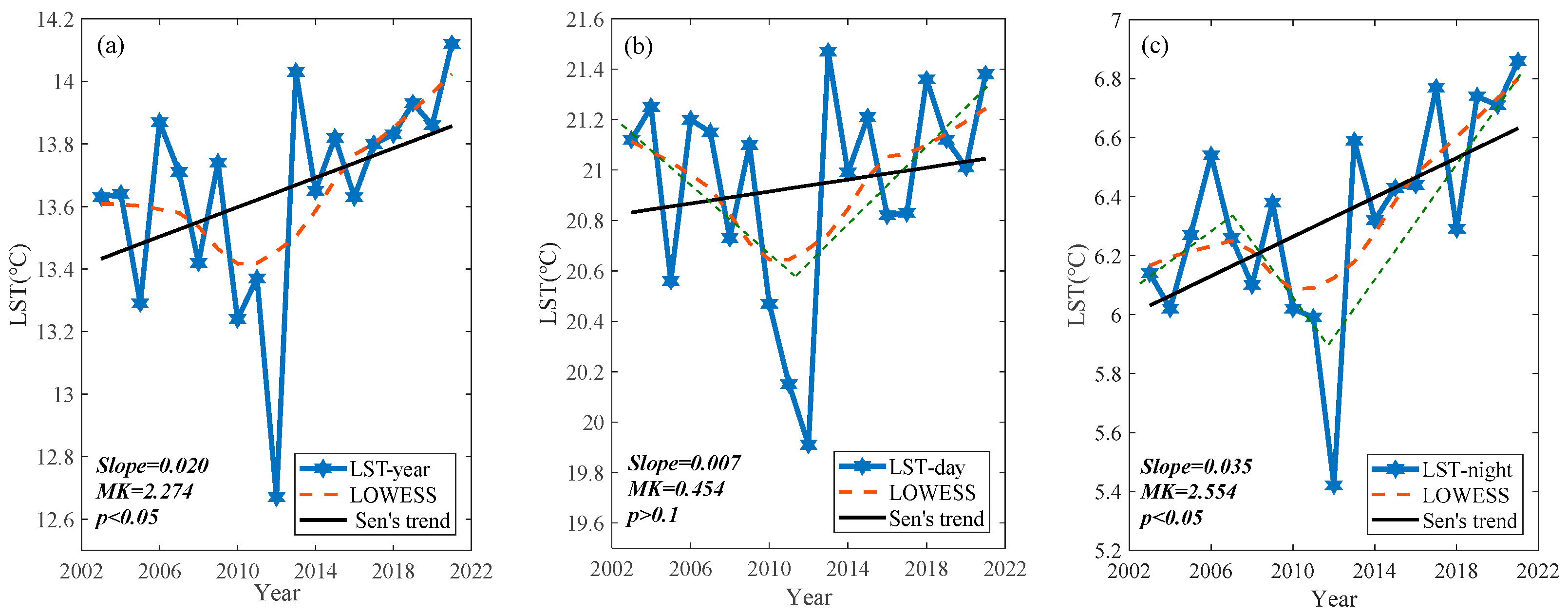
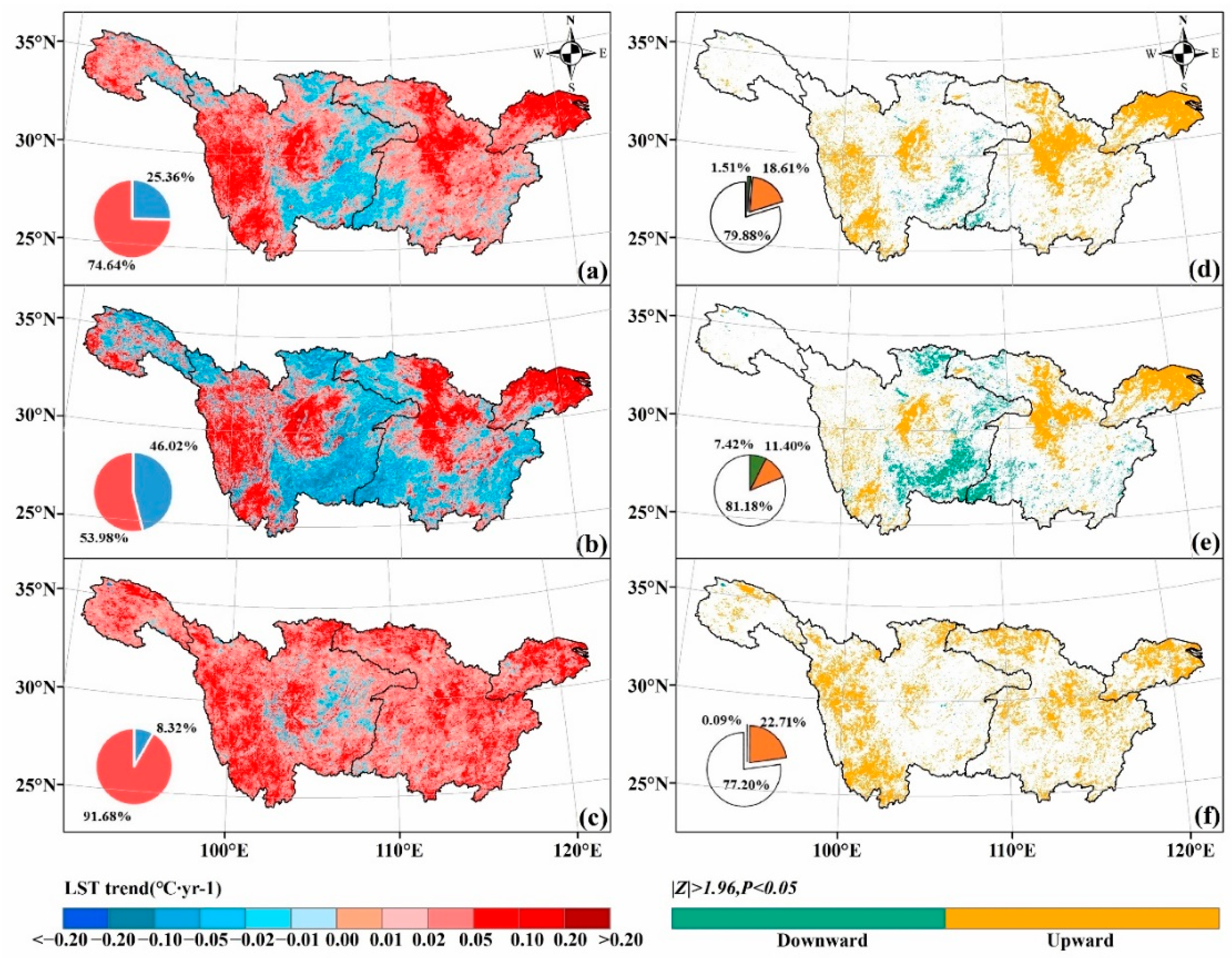
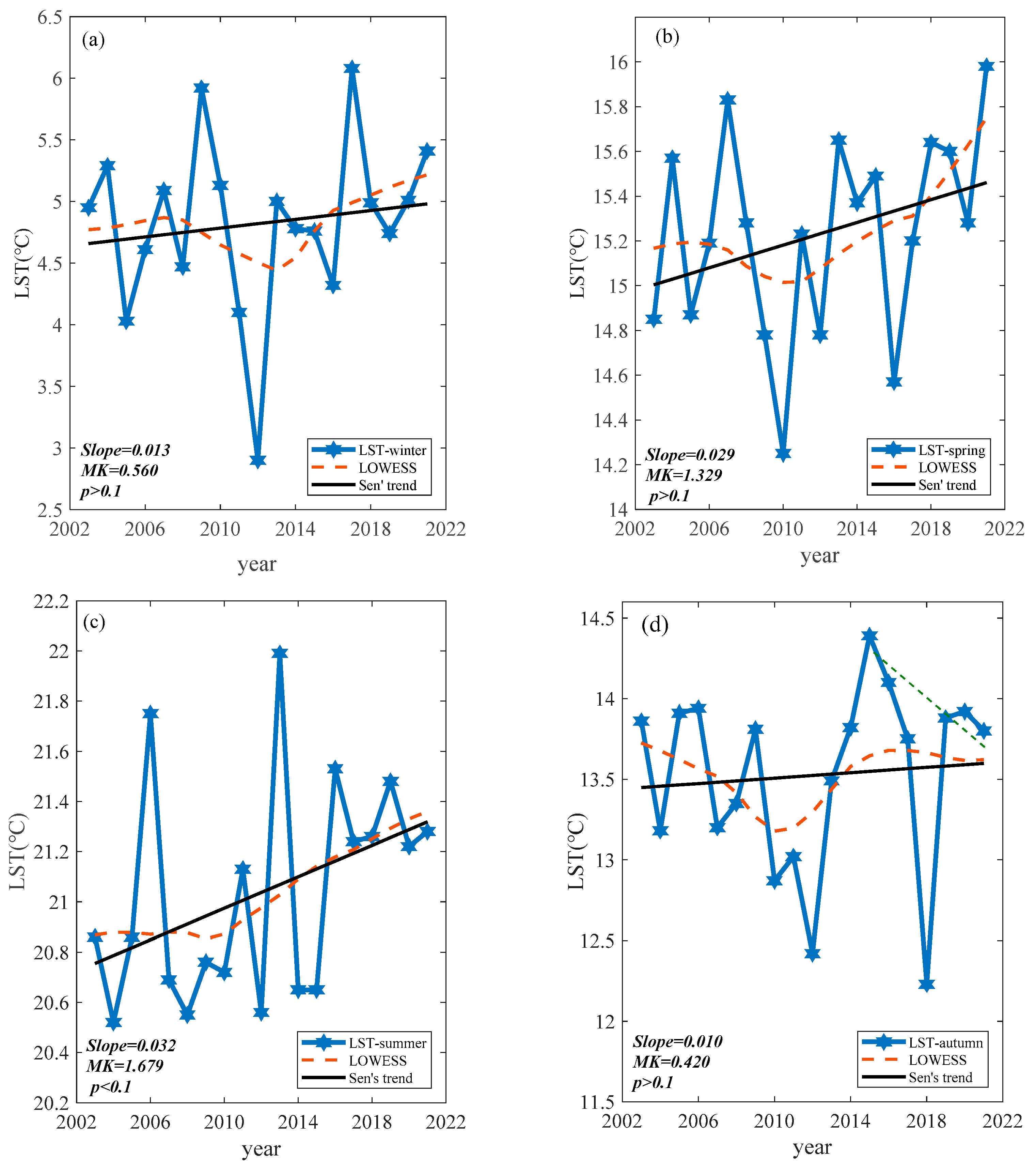
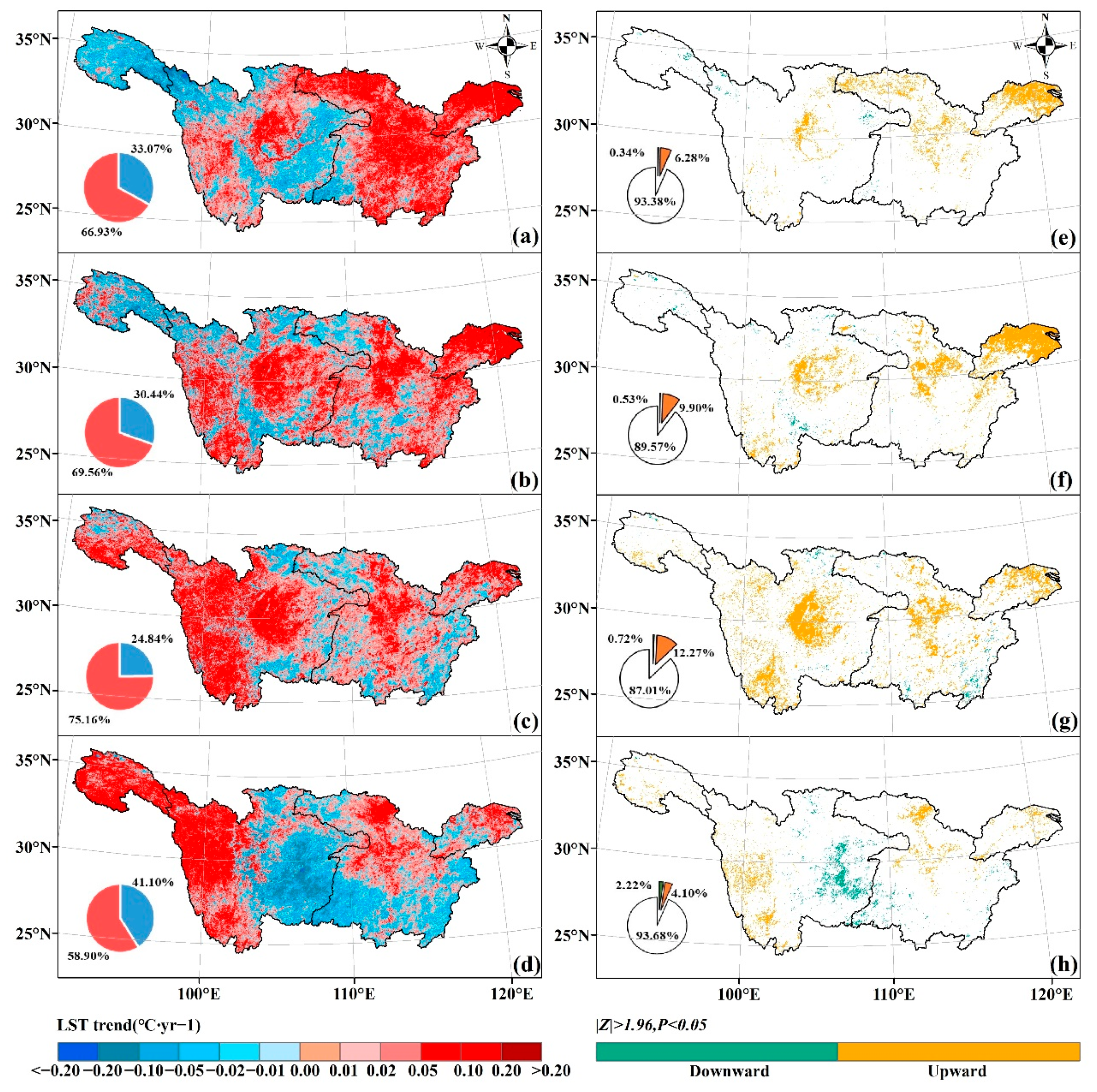
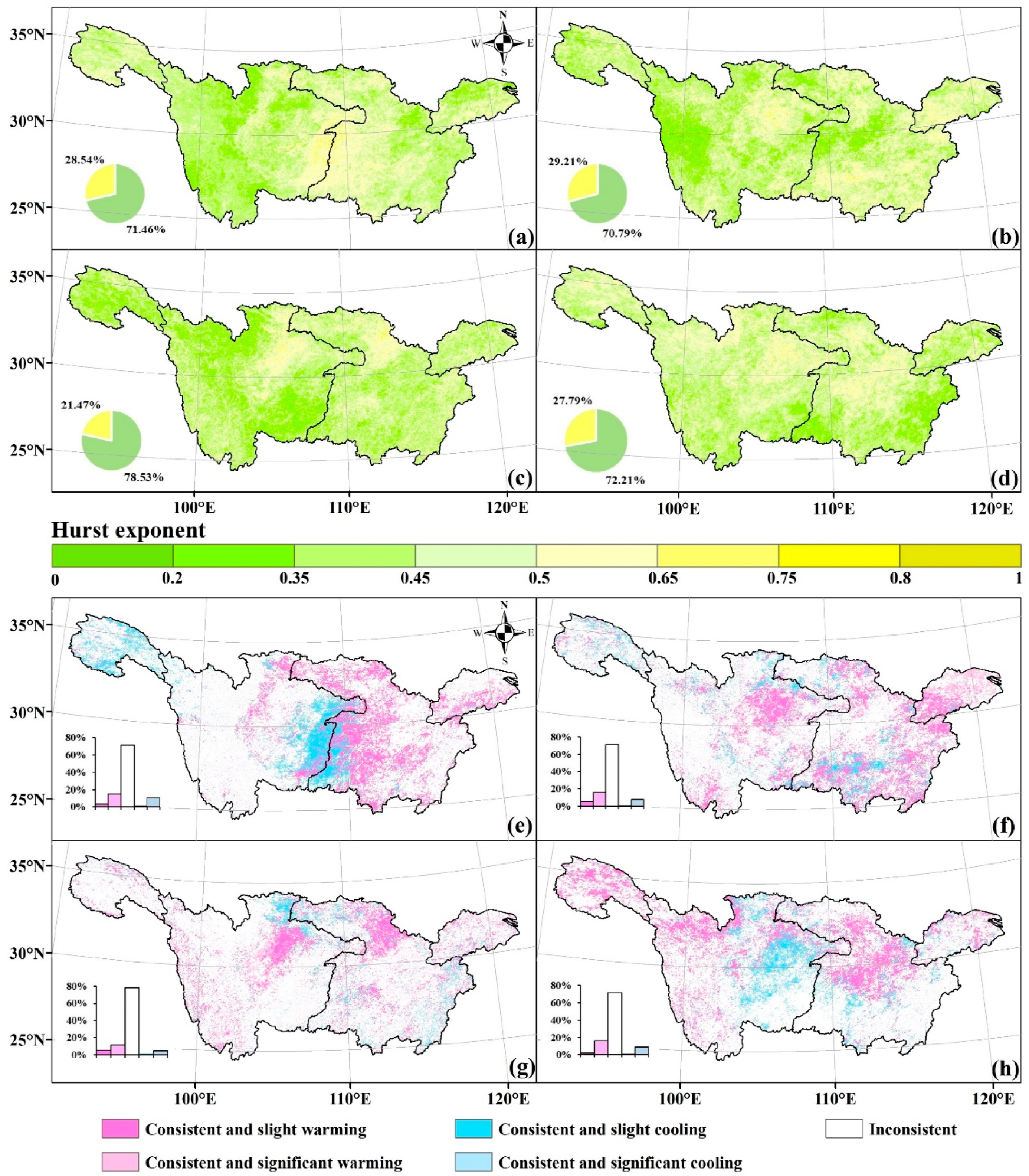

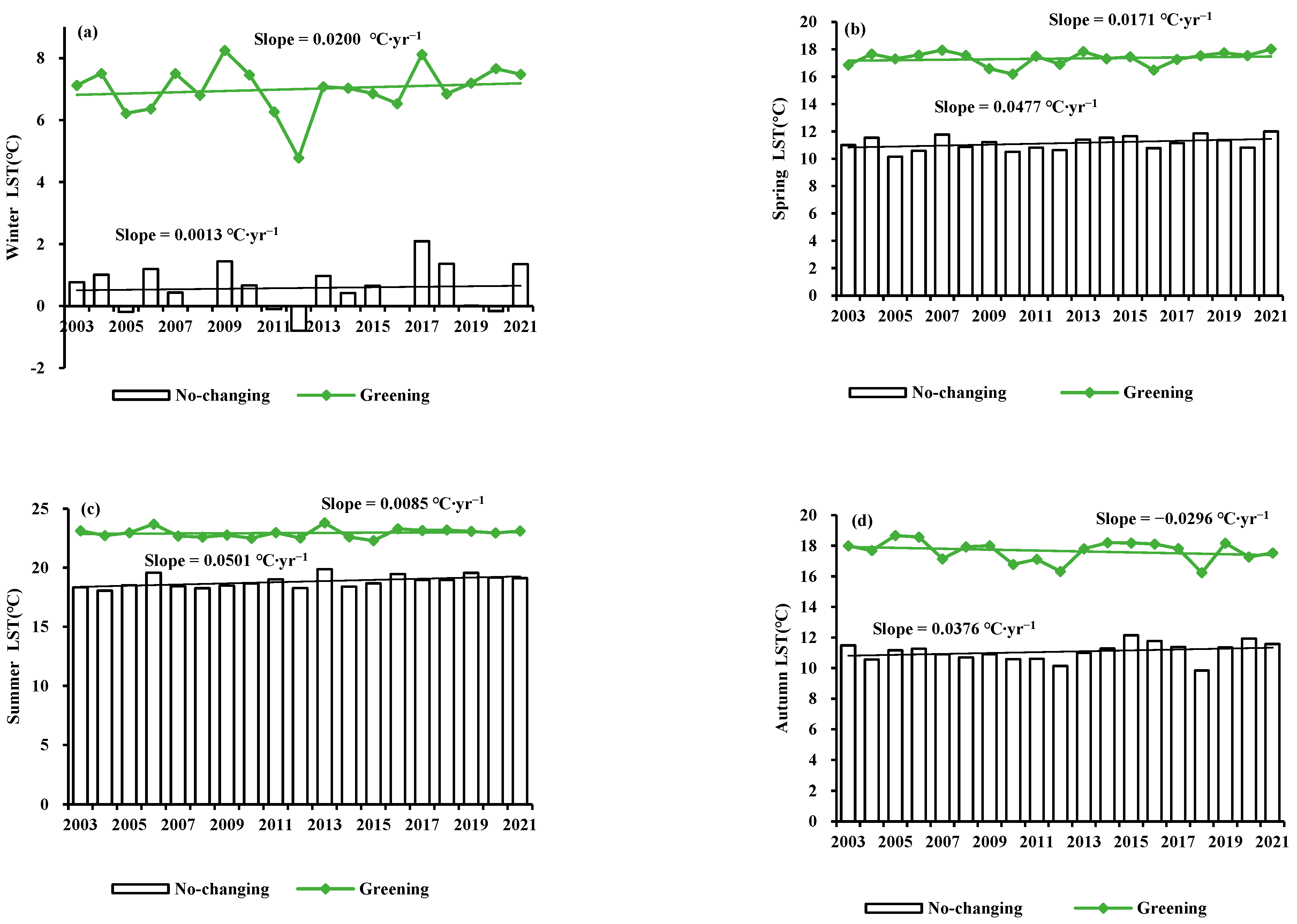

| Vegetation Type | Reclassified Vegetation Type | Vegetation Type in IGBP | Multi-Year Mean NDVI |
|---|---|---|---|
| Dense vegetation | Forest | Evergreen Needleleaf Forest | >0.55 |
| Evergreen Broadleaf Forest | |||
| Deciduous Needleleaf Forest | |||
| Deciduous Broadleaf Forest | |||
| Mixed Forest | |||
| Closed Shrubland | |||
| Open Shrubland | |||
| Woodland | Woody Savannas | ||
| Savannas | |||
| Moderate vegetation | Wetland | Permanent Wetland | 0.35–0.55 |
| Cropland | Cropland | ||
| Cropland/Natural Vegetation Mosaic | |||
| Sparse vegetation | Grassland | Grassland | 0–0.35 |
| Barren land | Barren | ||
| Urban land | Urban and Built-up land | ||
| No vegetation | Water | Water BodiesPermanent Snow and Ice | - |
| Slope | p | H | Types |
|---|---|---|---|
| >0 | <0.05 | >0.5 | consistent and significant warming |
| >0 | >0.05 | >0.5 | consistent and slight warming |
| <0 | <0.05 | >0.5 | consistent and significant cooling |
| <0 | >0.05 | >0.5 | consistent and slight cooling |
| - | - | <0.5 | inconsistent |
| LC | Periods | Sen’s Slope | Correlation | ||||
|---|---|---|---|---|---|---|---|
| LST | MK Test | NDVI | MK Test | R | P | ||
| Forest | Winter | 0.0235 | 1.1195 | 0.0058 ** | 4.9680 | 0.281 | 0.245 |
| Spring | 0.0188 | 0.9096 | 0.0049 ** | 4.3032 | 0.394 • | 0.095 | |
| Summer | 0.0206 | 1.1195 | 0.0025 ** | 5.3878 | 0.278 | 0.249 | |
| Autumn | 0.0079 | 0.4198 | 0.0030 ** | 4.4782 | 0.195 | 0.425 | |
| Woodland | Winter | 0.0253 | 0.6997 | 0.0057 ** | 4.9680 | 0.179 | 0.464 |
| Spring | 0.0260 | 1.0496 | 0.0053 ** | 4.6531 | 0.359 | 0.132 | |
| Summer | 0.0241 | 1.6093 | 0.0025 ** | 5.0379 | 0.162 | 0.507 | |
| Autumn | −0.0141 | −0.9096 | 0.0043 ** | 4.7580 | −0.214 | 0.378 | |
| Wetland | Winter | 0.0355 | 0.7697 | 0.0008 | 1.1895 | 0.401 • | 0.089 |
| Spring | 0.0007 | 0.0002 | 0.0011 ** | 2.6239 | 0.631 ** | 0.004 | |
| Summer | 0.0477 • | 1.8192 | −0.0016 * | −2.3090 | −0.295 | 0.220 | |
| Autumn | 0.0956 • | 1.8192 | 0.0006 | 1.4694 | 0.215 | 0.376 | |
| Cropland | Winter | 0.0825 * | 2.0292 | 0.0031 ** | 3.5685 | 0.220 | 0.365 |
| Spring | 0.0580 * | 2.1691 | 0.0010 * | 2.4840 | 0.494 * | 0.032 | |
| Summer | 0.0312 | 1.2994 | 0.0002 | 0.7697 | 0.082 | 0.739 | |
| Autumn | −0.0285 | −1.2595 | 0.0015 ** | 2.5889 | −0.148 | 0.546 | |
| Grassland | Winter | −0.0355 | −1.2595 | 0.0047 ** | 3.9184 | 0.632 ** | 0.004 |
| Spring | 0.0512 * | 2.3090 | 0.0038 ** | 4.5131 | 0.609 ** | 0.006 | |
| Summer | 0.0365 | 1.4694 | 0.0021 ** | 3.8484 | 0.145 | 0.553 | |
| Autumn | 0.0055 | 0.2099 | 0.0044 ** | 4.4782 | 0.451 • | 0.053 | |
| Urban land | Winter | 0.0858 * | 2.0991 | 0.0021 ** | 3.0088 | 0.511 * | 0.025 |
| Spring | 0.1200 ** | 3.7784 | 0.0007 | 1.6443 | 0.467 * | 0.044 | |
| Summer | 0.1021 ** | 3.7085 | −0.0017 ** | −2.8688 | −0.691 ** | 0.001 | |
| Autumn | 0.0499 • | 1.8192 | 0.0008 * | 2.0292 | 0.345 | 0.148 | |
| Barren land | Winter | −0.0271 | −0.4898 | 0.0007 | 1.3994 | 0.609 ** | 0.006 |
| Spring | −0.0162 | −0.2099 | 0.0004 | 1.6443 | 0.614 ** | 0.005 | |
| Summer | 0.0418 • | 1.7493 | 0.0010 ** | 2.9388 | 0.293 | 0.224 | |
| Autumn | 0.0900 | 1.3994 | 0.0004 * | 2.1691 | 0.450 • | 0.053 | |
Publisher’s Note: MDPI stays neutral with regard to jurisdictional claims in published maps and institutional affiliations. |
© 2022 by the authors. Licensee MDPI, Basel, Switzerland. This article is an open access article distributed under the terms and conditions of the Creative Commons Attribution (CC BY) license (https://creativecommons.org/licenses/by/4.0/).
Share and Cite
Liu, J.; Liu, S.; Tang, X.; Ding, Z.; Ma, M.; Yu, P. The Response of Land Surface Temperature Changes to the Vegetation Dynamics in the Yangtze River Basin. Remote Sens. 2022, 14, 5093. https://doi.org/10.3390/rs14205093
Liu J, Liu S, Tang X, Ding Z, Ma M, Yu P. The Response of Land Surface Temperature Changes to the Vegetation Dynamics in the Yangtze River Basin. Remote Sensing. 2022; 14(20):5093. https://doi.org/10.3390/rs14205093
Chicago/Turabian StyleLiu, Jinlian, Shiwei Liu, Xuguang Tang, Zhi Ding, Mingguo Ma, and Pujia Yu. 2022. "The Response of Land Surface Temperature Changes to the Vegetation Dynamics in the Yangtze River Basin" Remote Sensing 14, no. 20: 5093. https://doi.org/10.3390/rs14205093
APA StyleLiu, J., Liu, S., Tang, X., Ding, Z., Ma, M., & Yu, P. (2022). The Response of Land Surface Temperature Changes to the Vegetation Dynamics in the Yangtze River Basin. Remote Sensing, 14(20), 5093. https://doi.org/10.3390/rs14205093








